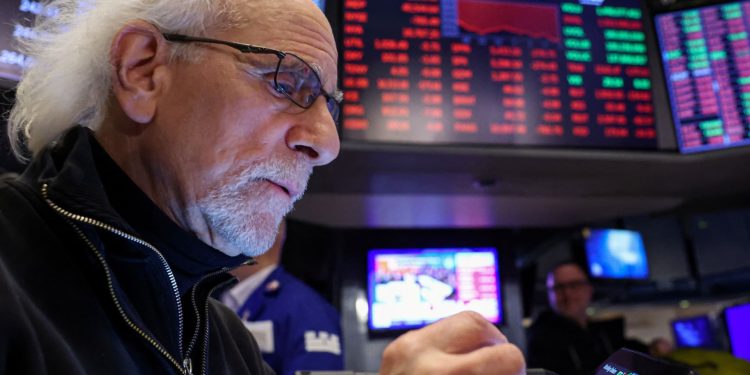A merchant works on the prosecution on the New York Stock Exchange (NYSE) in New York, United States, April 3, 2025.
Brendan McDermid | Reuters
Dow Jones Industrial Middle Tower SLID Thursday evening after President Donald Trump’s pricing plan sparked the greatest slide in American actions in five years.
The trial contracts linked to the first -rate index lost 77 points, or 0.2%, after the average of 30 stocks dropped by more than 1,600 points in the previous session. Future S&P 500 lost 0.1%, and Nasdaq 100 Futres were slightly lower.
Thursday evening’s action has followed the worst day since 2020 for each of the three main indices. THE Dow And S&P 500 fell by around 4% and 4.8%, respectively, while the technology is heavy Nasdaq Composite Immersed almost 6%.
The S&P 500 is resumed in a correction Thursday, down more than 10% compared to its February summit. The little captain focused Russell 2000 Dove more than 6%, the first measure widely followed by American shares to enter a lower market, a drop of at least 20% compared to its last peak.
Thursday sales technology actions are particularly difficult, with the magnificent CNBC index, with more than 6% CNBC. Collectively, the actions of the “Magnificent Seven”, which led the higher market in 2023 and 2024, lost more than 1 billion of dollars of market value.
The Nasdaq Composite paved the way for the decline in stocks this week, down 4.5% while the tariff plan prompted investors to reduce their exposure to risks. Industrialists S&P 500 and DOW have slipped 3.3% and 2.5% respectively, one week to date. The Nasdaq and the S&P 500 follow their worst weekly performance since September 2024 and the sixth negative week of the last seven.
The global markets were sold after Trump announced on Wednesday a basic rate rate of 10% on goods imported from all countries entering into force on April 5. Several countries face much higher samples, according to the White House.
Investors are now wondering if countries will be able to conclude trade agreements with the United States to reduce prices. Trump said on Thursday that it was open to commercial negotiations, an approach to previous statements by administration officials.
“The Trump administration can play a chicken game with business partners, but market players are not willing to wait for the results,” said Michael Arone, chief SPDR investment strategist at State Street Global Advisors. “Investors sell first and ask questions later.”
Friday morning, investors will focus on the job report closely in March. Economists interviewed by Dow Jones expect the non -agitated wage bill increases by 140,000 jobs and that the unemployment rate is stable to 4.1%.


